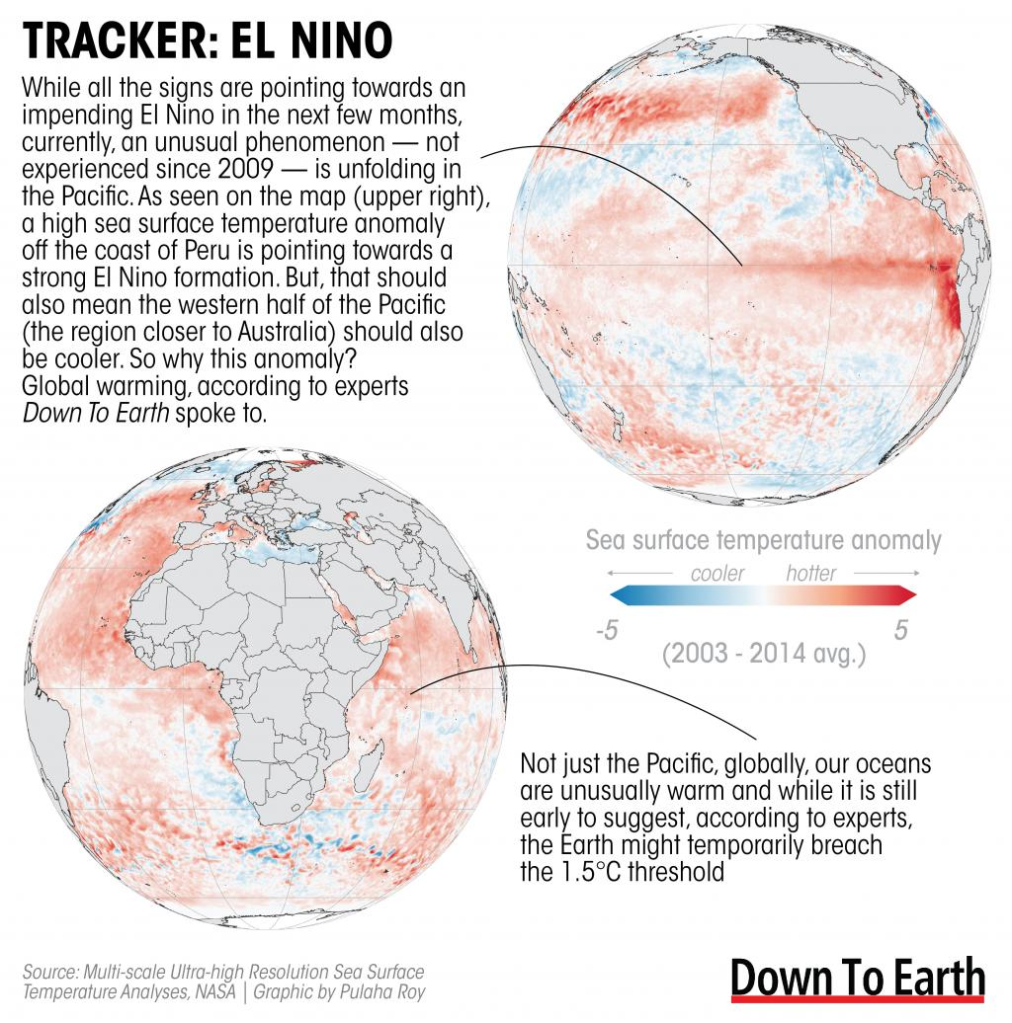El Nino 2023: Warming this year last seen in 2009; may cause global marine devastation; here’s how
June 16, 2023 Journal of People Peasants and Workers
The end of La Nina means the ocean is not taking up heat which will escape to the atmosphere; oceans retaining heat will kill marine life

Marine heatwaves could cause a mass coral dieoff. Photo: Stock
Even as all climatological signals are pointing to an impending El Nino condition, an unusual phenomenon is developing along the equatorial Pacific region, which was last experienced in 2009, experts have told Down To Earth (DTE).
Raghu Murtugudde, professor of atmospheric and oceanic science at the University of Maryland, told DTE about what exactly happened in such circumstances:

But it is not just the equatorial Pacific. Data analysed by DTE shows the world’s oceans were unusually warm for May 29, 2023, when compared to the 2003-2014 average.
According to Murtugudde, two things could have triggered it. “There is global warming in the Pacific and some other modes of natural variability including the transition from the La Nina winter into an El Nino summer,” he said.
How unprecedented is the situation from a climatological stand point?
According to Murtugudde, the end of La Nina means the ocean is not taking up heat. So it will dissipate into the atmosphere. If the atmosphere is warmer, then the ocean doesn’t lose as much heat so it warms up at the surface.
“It may temporarily push global warming beyond 1.5°C but we have to wait and watch. It will affect cyclones, hurricanes and typhoons. Typhoon Mawar in the western Pacific is already one of the strongest,” he said.
El Nino is the warming phase of the El Nino-Southern Oscillation, or ENSO, a recurring climate pattern involving changes in the temperature of waters in the central and eastern tropical Pacific Ocean, according to the United States National Oceanic and Atmospheric Administration.
The 1.5°C threshold (of the 2015 Paris Agreement) is mostly centered around climatological consequences. But the warming of ocean waters acts as a domino for marine heatwaves. This could cause unmitigable losses for marine biodiversity.
According to the United Nations, “a warming of 1.5°C threatens to destroy 70 to 90 per cent of coral reefs, and a 2°C increase means a nearly 100 per cent loss — a point of no return”.
THANKS TO: https://journalworker.wordpress.com/2023/06/16/el-nino-2023-warming-this-year-last-seen-in-2009-may-cause-global-marine-devastation-heres-how/
June 16, 2023 Journal of People Peasants and Workers
The end of La Nina means the ocean is not taking up heat which will escape to the atmosphere; oceans retaining heat will kill marine life
Pulaha Roy
Down To Earth | June 06, 2023

Marine heatwaves could cause a mass coral dieoff. Photo: Stock
Even as all climatological signals are pointing to an impending El Nino condition, an unusual phenomenon is developing along the equatorial Pacific region, which was last experienced in 2009, experts have told Down To Earth (DTE).
Raghu Murtugudde, professor of atmospheric and oceanic science at the University of Maryland, told DTE about what exactly happened in such circumstances:
A ‘basin scale’ is a spatial measurement of a basin or common outlet for water runoff, in this case the equatorial Pacific region.When the eastern Pacific gets warmer, the west should typically get cooler. But due to global warming, we end up with basin scale warming in the tropical Pacific.

But it is not just the equatorial Pacific. Data analysed by DTE shows the world’s oceans were unusually warm for May 29, 2023, when compared to the 2003-2014 average.
According to Murtugudde, two things could have triggered it. “There is global warming in the Pacific and some other modes of natural variability including the transition from the La Nina winter into an El Nino summer,” he said.
How unprecedented is the situation from a climatological stand point?
According to Murtugudde, the end of La Nina means the ocean is not taking up heat. So it will dissipate into the atmosphere. If the atmosphere is warmer, then the ocean doesn’t lose as much heat so it warms up at the surface.
“It may temporarily push global warming beyond 1.5°C but we have to wait and watch. It will affect cyclones, hurricanes and typhoons. Typhoon Mawar in the western Pacific is already one of the strongest,” he said.
El Nino is the warming phase of the El Nino-Southern Oscillation, or ENSO, a recurring climate pattern involving changes in the temperature of waters in the central and eastern tropical Pacific Ocean, according to the United States National Oceanic and Atmospheric Administration.
The 1.5°C threshold (of the 2015 Paris Agreement) is mostly centered around climatological consequences. But the warming of ocean waters acts as a domino for marine heatwaves. This could cause unmitigable losses for marine biodiversity.
According to the United Nations, “a warming of 1.5°C threatens to destroy 70 to 90 per cent of coral reefs, and a 2°C increase means a nearly 100 per cent loss — a point of no return”.
SOURCE: https://www.downtoearth.org.in/news/climate-change/el-nino-2023-warming-this-year-last-seen-in-2009-may-cause-global-marine-devastation-here-s-how-89873
[THIS IS POSTED HERE FOR NON-PROFIT, NON-COMMERCIAL, EDUCATIONAL PURPOSE.]THANKS TO: https://journalworker.wordpress.com/2023/06/16/el-nino-2023-warming-this-year-last-seen-in-2009-may-cause-global-marine-devastation-heres-how/






 Sat Mar 23, 2024 11:33 pm by globalturbo
Sat Mar 23, 2024 11:33 pm by globalturbo

